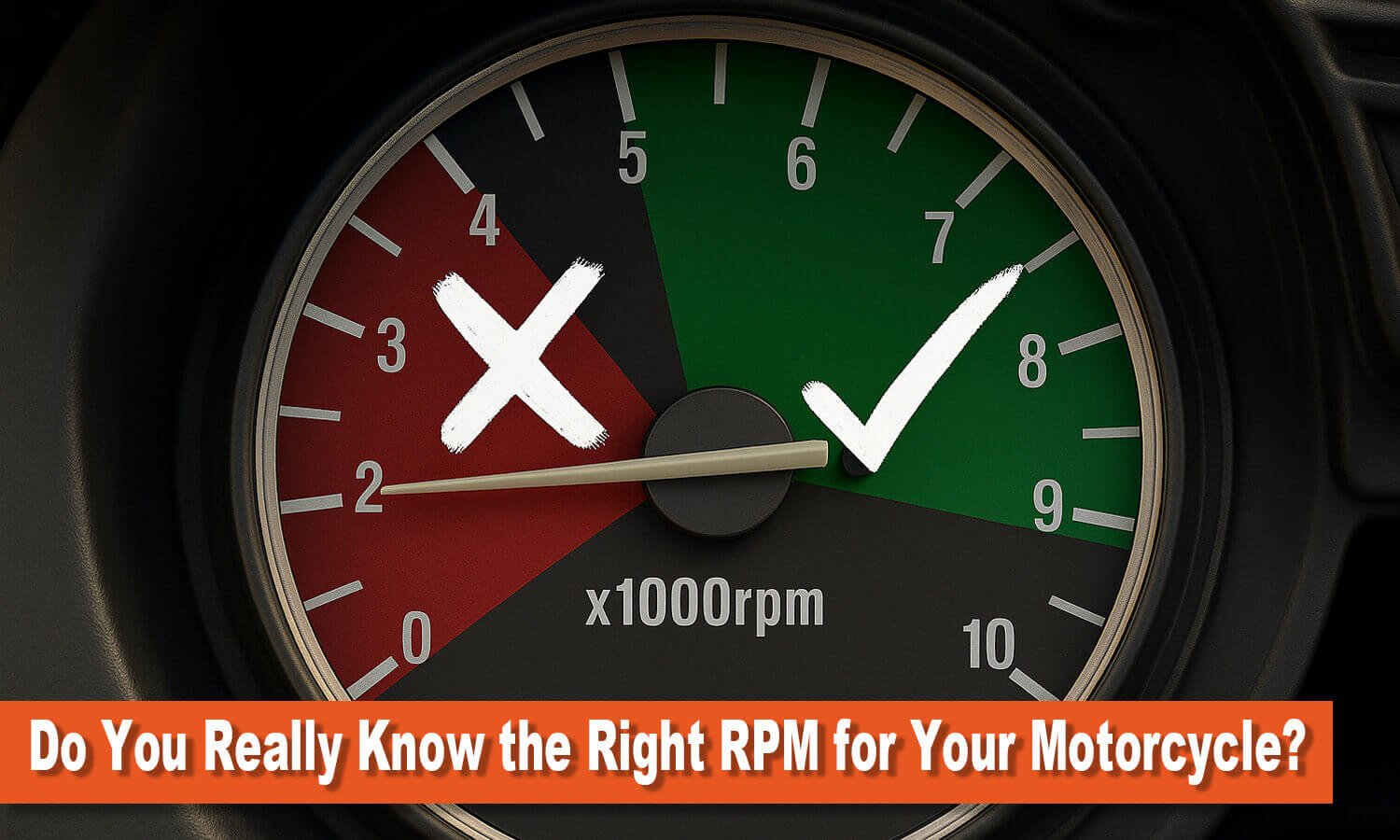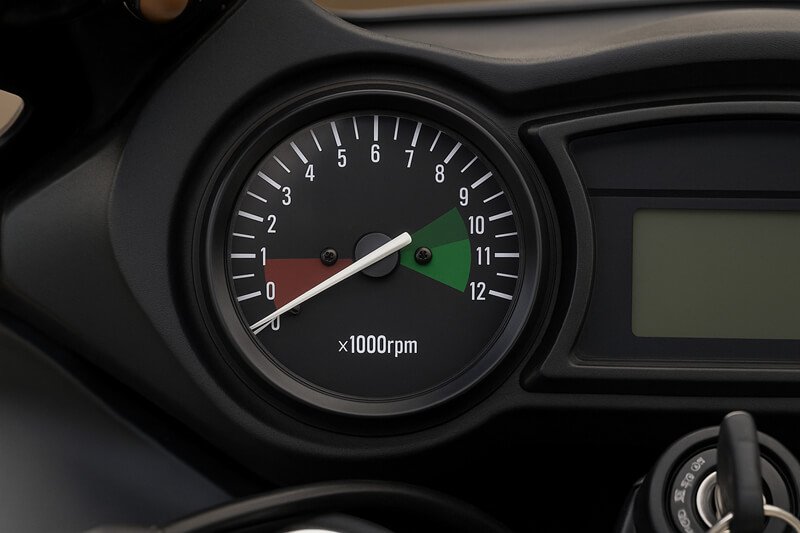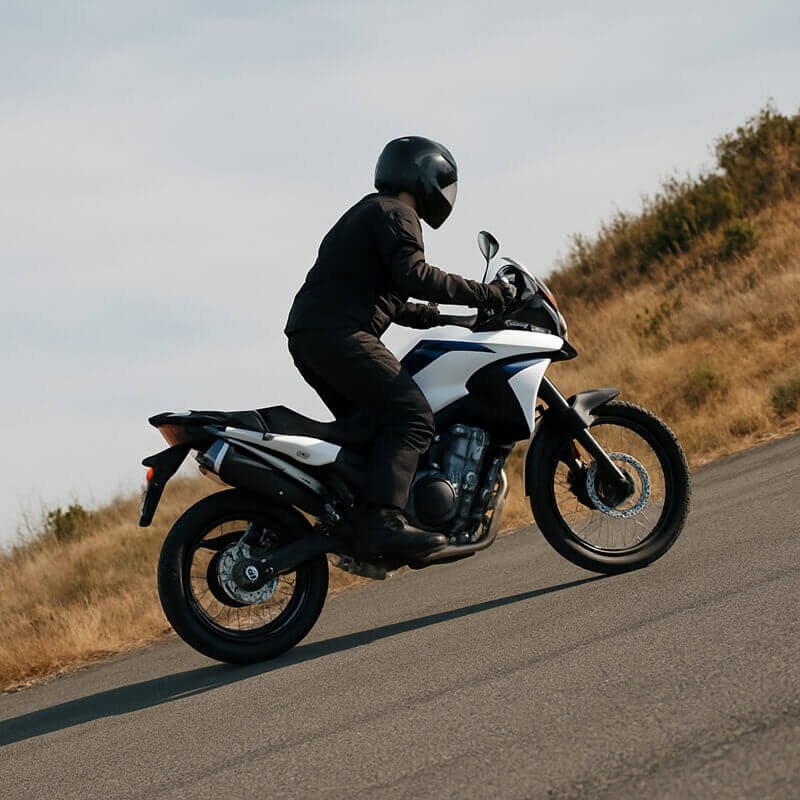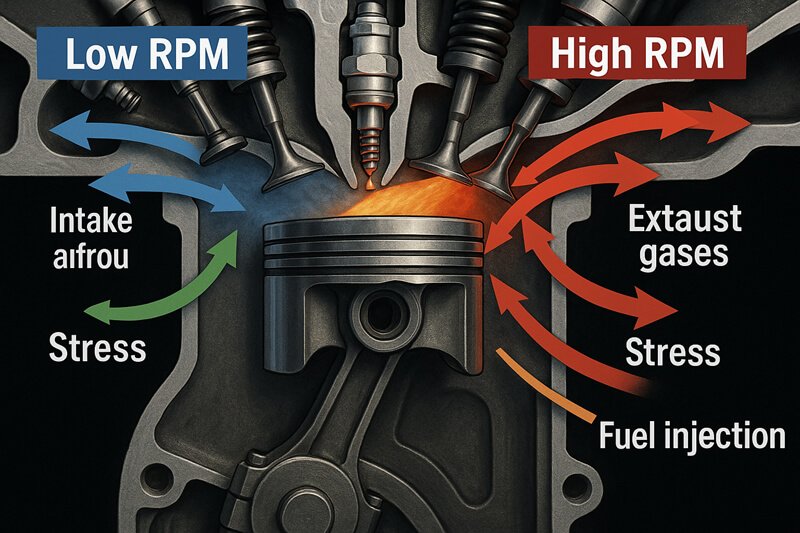Getting your snowmobile’s track adjusted correctly doesn’t have to be complicated. In this guide, we’ll show you the tools, step-by-step instructions, and troubleshooting tips for all major brands — Polaris, Ski‑Doo/Lynx, Arctic Cat, Yamaha, and more. If you do it right, your snowmobile will run great quickly. Why Track Tension Matters Track tension directly affects […]

Do You Really Know the Right RPM for Your Motorcycle?
Today's motorcycles pack a punch with engines built to rev high, but many riders aren't clear on the ideal operating range. Engines work best within specific RPM (revolutions per minute) ranges to deliver power, efficiency, and durability. Riding too slow in a high gear (called lugging) or always pushing the red line can damage the engine.
In this article, we'll break down why the right RPM is crucial, the dangers of lugging, the pros and cons of high RPM vs. low RPM, and how to use the full rev range to keep your bike running for years to come.
Table of Contents
Understanding RPM and Engine Performance
RPM (Revolutions Per Minute) measures how fast the engine’s crankshaft is spinning. In a four-stroke motorcycle engine, the pistons fire in sequence (“bang, ding, ding, dong” on a four-cylinder) to turn the crankshaft.
Each firing stroke produces power, and the engine’s power and torque curves depend on RPM. Every engine has a powerband, a range of RPM where it makes the best torque and horsepower. Riding within that range usually gives the smoothest power delivery and efficiency.
On most street bikes, the ideal cruising RPM might be around 2,000–3,000 RPM (often called the “Goldilocks zone”), though this varies by bike type. For example, sportbikes typically make peak power at 7,000–10,000 RPM, while cruisers run smoothly at 2,500–4,000 RPM. Always consult your owner’s manual or torque curves for your specific model, but a good rule of thumb is to shift so the bike stays around half of its maximum RPM.

motorcycle tachometer
Keeping RPM in a healthy range means the engine runs hot enough to burn fuel cleanly, without constantly redlining. Using the tachometer (“rev counter”) helps: stay out of the red zone, but don’t baby the throttle either. Running at ultra-low RPMs can actually prevent the engine from reaching ideal operating temperature and burn out unburned fuel, which leads to problems (see below).
In short, proper RPM management ensures smoother riding, better fuel efficiency, and longer engine life.
What Is “Lugging” and Why Avoid It
“Lugging” refers to forcing the engine to move the bike at too low an RPM in a high gear. For example, trying to climb a hill in 6th gear at 2,000 RPM is lugging. In this situation, the throttle is open but the engine can’t rev up enough.

The motorcyclist is climbing the hill at low RPMs
Mechanics compare lugging to “hammering the engine parts with every explosion”. Every combustion stroke pushes hard against the engine load, straining parts:
Piston and Cylinder Stress
At very low RPM under load, each power stroke delivers a strong jolt. This can make the pistons “slap the side of the cylinders hard” and pound on the crankshaft’s rod bearings. Over time this hammering causes wear on pistons, rings, bearings, and even the transmission.
Bearing and Clutch Wear
The rod bearings and crankshaft main bearings see extra torque spikes. Even the transmission and clutch (which absorb some shock) can wear faster. The Stack Exchange engineering explanation says lugging “racks on the rod bearing/journals... and if done enough, could probably break piston rings”.
Engine Knock (Detonation)
Lugging often leads to a heavy throttle at low RPM. This can cause fuel to ignite prematurely (ping or knock) because combustion pressure rises quickly. Notably, engine expert Kevin Cameron points out that detonation is “less of an issue at high RPM”, implying it’s more of a risk when RPM are low. Low-speed knock can damage pistons and valves.
Incomplete Combustion and Carbon
At low RPM, the engine runs cooler and the exhaust may not be hot enough to burn off byproducts. This leads to soot and carbon building up on pistons, valves, and spark plugs. Over time, heavy carbon deposits foul plugs, reduce compression, and hurt performance.
Shudder and Response
Lugging can make the bike feel jerky or shaky. You might feel vibrations or “judder” if the cylinders don’t fire smoothly. The engine struggles to pull the load, so throttle response is sluggish.
In summary, lugging is like using the engine as a hammer. It doesn’t immediately destroy the engine, but it causes unnecessary wear and stress. If you want your engine to last, avoid constantly riding in a gear too high for your speed.
The fix is simple: downshift or slip the clutch and rev up a bit before pulling away. For instance, many mechanics advise starting from a stop at around 1,500–2,000 RPM before releasing the clutch. This little extra rev means the engine can work smoothly, not under constant strain. Over time, releasing the clutch with gentle throttle and maintaining at least ~1500 RPM from a standstill becomes second nature.
High RPM vs. Low RPM
Balancing engine speed is a trade-off. Below is a summary of the pros and cons of running at higher RPM versus very low RPM (lugging):

High RPM vs. Low RPM
Carbon Control
High RPM generates higher exhaust and chamber temperatures. That heat can burn off carbon deposits.
In fact, one maintenance guide notes that “increasing the engine RPMs helps the motor to burn-off carbon buildup” when the engine is at operating temperature. In practice, taking your bike for a spirited run (when safe) can help clear out gunk.
By contrast, prolonged low-rpm riding (especially stop-and-go traffic) encourages carbon to accumulate, which can foul cylinders and valves.
Engine Heat and Efficiency
Operating at very low RPM (especially cold or in high gear) can cool parts of the engine below ideal. Fuel may not vaporize fully and residues stick around.
Higher RPM keeps oil circulated and engine bay warmer, which actually improves efficiency by ensuring more complete combustion and proper oil flow.
Mechanical Stress per Stroke
At high RPM, pistons cycle more times per minute, so the total wear can be higher over time. However, each individual power pulse occurs when moving fast, so pressure tends to be released more smoothly.
At low RPM, there are fewer power strokes but each one hits hard. That means more force per explosion, which can create “hot spots” and stresses that lead to knock or even piston damage (the dreaded “kaboom”).
Fuel Consumption
Generally, riding at higher RPM burns more fuel (since the engine is doing more work overall). That means fuel economy can drop if you redline constantly. However, lugging isn’t great for economy either. Incomplete combustion and engine strain at low RPM can result in inefficient fuel use.
Most manufacturers note that best mileage often comes in the mid-range – for some bikes around 4,000–5,000 RPM (though the exact figure varies widely by engine design). Riding in the optimal part of the powerband (where torque peaks) usually yields the best fuel economy without lugging.
Throttle and Traction Control (if equipped)
Many modern bikes use traction control (TC) or other stability systems. These systems often intervene based on wheel speed and engine torque.
While specifics vary, note that at higher RPMs the engine’s response to throttle is quicker, and TC can modulate power pulses at a faster rate. At low RPM, the system has less resolution to work with. In general, though, it’s safest to keep steady revs rather than strain the engine.
Noise and Vibration
High revs mean more engine noise and vibration. If you prefer a quiet, smooth ride, cruising at moderate RPM (instead of screaming the engine) is more comfortable for you and other road users.
Low RPM is quieter, but again, it can be at the cost of engine health if you’re lugging.
In practice, using a broad rev range is best. Letting the engine spin freely through its designed RPM spectrum is not abuse; it’s actually what the engine was built for.
Modern four-stroke engines expect to be revved, and their parts (lightweight pistons, narrow-cam profiles, precise fueling) work best when used. In other words, don’t fear the tachometer’s higher numbers – use them appropriately.
Finding the Right RPM Range
Every motorcycle has its own “happy spot,” but here are some general guidelines:
- Cruising RPM: For many bikes, about 2,000–3,000 RPM while cruising on flat roads is efficient and comfortable. This range usually provides enough power to accelerate smoothly without lugging. It also keeps the engine warm without screaming.
- Shifting RPM: As a rule of thumb, shift gears in the middle of the powerband, not at idle and not redline. Many riders shift up around 4,000–7,000 RPM when accelerating (listen for a throaty engine note) and let the next gear settle in around 3,000–4,000 RPM. This keeps the engine lively. Of course, consult your manual: some manuals even list recommended shift points for fuel economy. If not, learning by feel is fine.
- Bike Type Matters: Sportbikes often rev much higher (engines tuned for high-RPM power). For example, liter-class sportbikes may deliver peak power at 10,000 RPM or more. A cruiser or touring bike with a torquey engine may feel happiest at 3,000–4,000 RPM. An adventure bike might run 4,000–6,000 RPM at highway speed. Always tailor your riding to your bike’s characteristics.
- Avoid “Stay-At-Home” RPM: If your bike is idling at 1,000 RPM in top gear and you try to accelerate heavily, you’re sure to lug. Likewise, don’t “short shift” too early to save fuel – that often backfires with lugging and weird load. Instead, shift so the engine revs up to a comfortable level before applying throttle.
- Use the Tachometer: Modern bikes have tachometers for a reason. Keep an eye on it. When accelerating, upshift before hitting redline. When slowing, downshift before speed drops so low that RPM falls below an efficient range. Practice by glancing at the tach when you feel the bike struggle or roar, and adjust your gear use accordingly.
Remember: a brief engine test is helpful. When warming up or idling at a stop, the engine naturally drops toward idle RPM (~1,000 RPM). That’s fine when the bike is stationary, but once moving, keep the needle where the engine runs smoothly.
Listen to the engine: if it’s lugging, the sound may become dull or “garbled.” If it’s near peak power, it may sound very smooth and strong. Over time you’ll learn to “feel” if you’re in the wrong gear.
Practical Tips for Engine Health
To maximize engine life and performance, follow these practical tips:
- Avoid Lugging at All Costs: If the engine sounds strained or if accelerating causes bucking/pinging, you’re lugging. Downshift or slip the clutch to raise RPM. As noted, aim for at least ~1500 RPM when starting or crawling. Most riders naturally learn this, but it’s important: starting on a hill or in traffic, use the lower gear and more throttle rather than inching forward at idle RPM.
- Use Full RPM Range Occasionally: Once in a while (where safe and legal), open her up. This is sometimes called a “decarbonizing ride.” Running the engine up through the gears warms everything and can blow off some carbon. Maintenance guides confirm that “increasing the engine RPMs helps the motor to burn-off carbon buildup” when the engine is fully warm. Of course, don’t over-rev when the engine is cold. Wait until it’s up to operating temp.
- Smooth Throttle Control: Sudden throttling at low RPM (especially after lugging) can be rough on the engine. Try to apply throttle smoothly and progressively. Anticipate when you’ll need power, and shift beforehand rather than rolling on the throttle in a too-high gear.
- Regular Warm-Ups: Even before riding hard, let the bike idle a minute or two after starting. This warms up the oil and coolant. Avoid immediately redlining a cold engine. But also avoid riding a cold engine for long; find a moderate cruising RPM until it warms up fully.
- Periodic High-Load Use: If your riding is mostly around town or low speeds, occasionally take a longer ride or open the throttle up on a highway. This “works out” the engine. Old-school riders often say engines need to be used, not just idled. Thorough warm-up followed by varying the RPM (light throttle to heavy throttle) is good.
- Maintain Proper Gear Ratios: Make sure your final drive (sprockets or shaft) is set up so that you don’t have to lug in top gear at legal speeds. Some bikes have very tall gearing; if yours forces you to constantly ride near idle in high gear, consider if a smaller top sprocket or bigger rear sprocket is advised (speak to a mechanic or look for riders’ forums on your model). The idea is to have a gear that suits your typical speed range.
- Use Quality Fuel and Tune-ups: Clean fuel and a tuned engine help maintain the right combustion at all RPM. Bad fuel or worn plugs/carburetors injectors can make carbon problems worse at any RPM. Keep up with regular tune-ups (plugs, oil, valves) so the engine can run smoothly. A well-tuned engine is more tolerant of low-RPM use because it won’t stumble as easily.
- Check for Problems if Symptoms Arise: If you notice excessive smoking, rough idling, or poor power at any RPM, investigate (e.g., carbon clogging). Sometimes valves or exhaust ports get coated, especially on fuel-injected bikes that don’t run a lot of high-RPM. Address buildup early, as it only gets worse if left.
Conclusion
Your motorcycle’s engine is happiest when run through its designed RPM range – not only at idle.
Modern four-stroke engines are engineered for high revs, and running them at moderate-to-high RPM actually helps them stay clean and responsive. In contrast, hanging in too-high a gear at low revs (lugging) can “hammer” the internals, cause carbon buildup and knock, and shorten engine life.
Using the tachometer, shifting at appropriate points, and occasionally giving the engine a spirited run will keep it operating safely.
In practice, most street bikes cruise well around 2,000–3,000 RPM (longer is in the manual). Remember that each bike is different: a big cruiser’s “happy” RPM band is much lower than a supersport’s.
By understanding how RPM affects combustion, engine stress, and emissions, you can respect the mechanical design and ride smarter.
Let the engine rev when it needs to, avoid lugging whenever possible, and follow the manufacturer's shift recommendations. That way, you’ll maintain performance, improve fuel efficiency, and give your motorcycle the smooth, powerful ride it deserves.
Top 3 Motorcycle Dangers and Prevention Strategies

Motorcycle mechanic, writer. Interested in motorcycle gear for years. Like to stay up to date with the newest products and techniques of the motorcycle.
Motorcycle riding is all about the sense of freedom, adventure, and thrill of the open road. But come on—being connected when you ride isn't always an easy thing. Whether you're riding with a buddy, navigating traffic in the city, or long-distance riding, effective communication is crucial. That's where the Fodsports T5 and T6 come in, […]
If you're looking for a new motorcycle intercom system this year, Fodsports has something exciting in store. The company has launched two new Bluetooth helmet intercoms: T1 and T1 Pro. Both models bring upgraded features, sleek design, and high-definition audio quality for riders who want to stay connected, entertained, and safe on the road. But […]
Fodsports T1 and T1 Pro: The Newest Bluetooth Intercoms for Riders. Whether you’re cruising on highways, exploring rugged trails, or commuting daily, clear communication is key. Fodsports is thrilled to launch its latest Bluetooth intercoms: the T1 and T1 Pro. Built for riders who demand reliability, versatility, and crystal-clear sound, these devices redefine how you […]
Many riders who aren't so tall or ladies just starting to ride bikes need to pick out the best Motorcycles for Short Riders and Women. They gotta look for three key things: a seat that's not too high up, a bike that's not too heavy, and something that looks good enough to give them confidence. […]
Fodsports FX 60C vs FX30C Pro: What's new techs are the FX 60C bringing to us? Fodsports is a brand worth-mention for helmet communication and video recording. This brand has established itself as a key player with its innovative Bluetooth camera intercom systems. Recently, Fodsports has released a new camera intercom, the FX 60C. How […]
